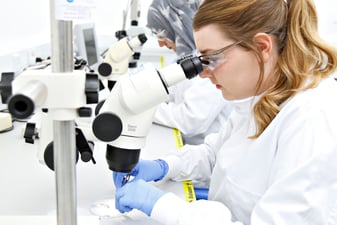Organ baths are a classical yet enduringly valuable tool in pharmacology, providing direct insight into how compounds affect tissue function. Despite the explosive growth in computational modeling, organ-on-chip, high-throughput screening, and other new approach methodologies (NAMs), there remains a critical and irreplaceable role for organ bath assays in preclinical drug discovery. By measuring parameters such as contraction, relaxation, and receptor activity in isolated tissues, organ bath assays deliver data that no in silico or cell-based model can fully replicate. For pharmaceutical companies, investing in CRO services that offer organ bath studies ensures access to data that are not only highly predictive of clinical outcomes but also critical for validating drug efficacy and safety before entering human trials.
Historical Importance of Organ Baths
The invention of the organ bath represents a pivotal moment in the evolution of experimental pharmacology. First introduced by Rudolph Magnus in 1904, the organ bath allowed researchers to mount isolated tissue samples in a controlled fluid environment and systematically test the effects of pharmacological agents. Through organ bath experiments, early pharmacologists were able to characterise the basic behaviour of smooth muscle in organs such as the intestine, blood vessels, uterus, and bronchioles, observing how tissues contract and relax in response to neurotransmitters, agonists, antagonists and other compounds. These experiments provided the first concrete evidence of receptor-mediated signaling in intact tissues and laid the groundwork for classifying receptor subtypes (e.g. muscarinic, adrenergic, histaminic). Over subsequent decades, organ baths underpinned many landmark drug discoveries, helping to validate lead compounds, define dose-response relationships, distinguish agonist vs antagonist activity and map out fundamental pharmacodynamic principles.1, 2
Continued Relevance in Preclinical Pharmacology
Across the pharmaceutical industry, approximately 90% of drug candidates that enter clinical trials fail during Phases I–III, underscoring the persistent challenges of translating preclinical success into clinical efficacy (NCBI, 2022; STAT, 2023)3,4. Of these failures, around 40–50% are due to a lack of efficacy, roughly 30% stem from safety issues or unmanageable toxicity, and 10–15% result from poor pharmacokinetic or drug-like properties, with the remainder attributed to strategic or commercial considerations (NCBI, 2022)5. A significant contributor to these high attrition rates is the limited functional validation of drug activity in physiologically relevant models. Traditional receptor-binding assays or cell-line systems, while valuable for early screening, often fail to replicate the complex interactions present in intact tissues. As a result, they may not accurately predict whether a compound will elicit the desired physiological response—such as vasorelaxation, bronchoconstriction, or modulation of gastrointestinal motility—once introduced into a living system.
A recent study using human pulmonary artery tissues obtained from lung resections demonstrated the continued relevance of organ bath assays in translational pharmacology. Researchers compared the vasodilatory effects of endothelin receptor antagonists (ERAs) and phosphodiesterase-5 inhibitors (PDE-5i)—two major drug classes used in the treatment of pulmonary arterial hypertension—when administered individually and in combination. Through detailed dose–response analyses in organ baths, the study revealed that the combined treatment produced a greater vasodilatory effect than either compound alone. These findings suggest that combination therapy could achieve equivalent or improved efficacy at lower doses, potentially reducing the risk of side effects in clinical use (PubMed, 2021)6.
Organ baths continue to be indispensable in preclinical pharmacology. They offer real-time, functional insights into how tissues respond to drugs—capturing dynamic processes such as smooth muscle contraction and relaxation, vascular tone modulation, and other physiological effects that are difficult to replicate in vitro. Unlike in silico or cell-based assays, organ bath studies preserve the structural and functional integrity of intact tissues, providing data that reflect true biological complexity. This makes them invaluable for receptor profiling, mechanism-of-action investigations, and dose-response analyses. By bridging the gap between molecular screening and in vivo studies, organ baths remain a gold standard for understanding how compounds perform in a physiologically relevant context.
Role in Drug Discovery and Development Today
Organ bath studies continue to play a critical role in identifying new drug targets and validating lead compounds across multiple therapeutic areas. By enabling precise measurement of tissue-level responses, these assays help researchers uncover novel mechanisms and confirm the pharmacological activity of candidate molecules before moving into more complex models. Organ baths remain particularly indispensable in gastrointestinal, cardiovascular, respiratory, and urogenital pharmacology—fields where smooth muscle function and receptor-mediated signaling are central to disease pathology. The detailed functional data generated from these studies inform key decisions in clinical trial design, such as dose selection and safety profiling, ultimately helping to reduce the risk of late-stage attrition. In this way, organ bath assays provide a vital bridge between discovery research and clinical success.
While new approach methodologies (NAMs)—including organ-on-chip systems, 3D in vitro models, and computational simulations—are transforming preclinical research, they still cannot fully replicate the biomechanical and neurochemical complexity of intact tissues. Many of these advanced systems lack the force generation, rhythmic contractility, innervation, and receptor diversity that define real physiological responses. As a result, ex vivo perfusion and organ bath studies remain essential benchmarks for validating the accuracy of NAMs. In fact, organ-on-chip platforms are often calibrated or cross-referenced with organ bath data to confirm their physiological relevance. By integrating NAMs, organ bath assays, and computational modeling within a unified in silico–in vitro–ex vivo–in vivo framework, researchers can achieve a more comprehensive understanding of drug behavior, improving translational predictivity and ultimately reducing clinical failure rates.
Reprocell’s Organ Bath Expertise as a CRO Offering
At REPROCELL, our organ bath services combine decades of pharmacological expertise with cutting-edge technology to deliver precise, reproducible results. Using state-of-the-art organ bath systems, our scientists conduct studies on both human and animal tissues to generate data that are physiologically relevant and directly translatable to clinical outcomes. Our expert pharmacologists ensure each study adheres to the highest standards of reproducibility, data integrity, and regulatory compliance—critical factors in supporting confident decision-making during drug development. By outsourcing organ bath studies to REPROCELL, pharmaceutical companies gain access to high-quality functional data without the time and resource burden of maintaining in-house facilities. This not only strengthens the predictability of preclinical findings but also accelerates R&D timelines, helping clients move promising therapies to the clinic faster and with greater confidence.
Organ bath assays remain a gold standard in functional pharmacology. In an era of rapid technological advancement, they deliver insights no in silico, NAM, or simple cell-based model can yet fully replicate: intact tissue function, receptor complexity, real dynamics of contraction/relaxation, modulation by physiological milieu. Given that about 90% of drug candidates entering clinical trials fail, with ~40-50% failing for lack of efficacy, investing early in functional, tissue-level studies is not optional but essential. Pharmaceutical companies that embed organ bath studies into their pipelines — either in-house or via expert CROs — strengthen their go/no-go decisions, improve the odds of translating promising molecules into safe, efficacious therapies, and reduce the risk of costly late-stage failures.
References:
1. Pharmacyinfoline. “Commonly Used Instruments in Experimental Pharmacology.” Pharmacy Infoline, 13 Aug. 2023, pharmacyinfoline.com/instruments-experimental-pharmacology/#google_vignette.
2. Tech Note "%*/4536.&/54 Organ Bath Systems Introduction:, cdn.adinstruments.com/adi-web/techniques/tn-Organ_Bath_Systems.pdf. Accessed 5 Nov. 2025.
3. Sun D, Gao W, Hu H, Zhou S. Why 90% of clinical drug development fails and how to improve it? Acta Pharm Sin B. 2022 Jul;12(7):3049-3062. doi: 10.1016/j.apsb.2022.02.002. Epub 2022 Feb 11. PMID: 35865092; PMCID: PMC9293739.
4. Mehta K, Maass C, Cucurull-Sanchez L, Pichardo-Almarza C, Subramanian K, Androulakis IP, Gobburu J, Schaller S, Sherwin CM. Modernizing Preclinical Drug Development: The Role of New Approach Methodologies. ACS Pharmacol Transl Sci. 2025 May 29;8(6):1513-1525. doi: 10.1021/acsptsci.5c00162. PMID: 40567279; PMCID: PMC12186754.
5. Stadlbauer C, Golovchenko S, Englert L, Spaeth M, Hoenicka M, Hofmann HS, Ried M. Organbadversuche an humanen Pulmonalgefäßen: Beurteilung der Medikamentenwirkung zur Behandlung der pulmonalarteriellen Hypertonie [Organ Bath Experiments on Human Pulmonary Vessels: Assessment of Drug Efficacy for Treatment of Pulmonary Arterial Hypertension]. Pneumologie. 2021 May;75(5):369-376. German. doi: 10.1055/a-1332-6892. Epub 2021 Jan 20. PMID: 33472251.
.jpg?width=1280&height=720&name=Untitled%20design%20(5).jpg)





